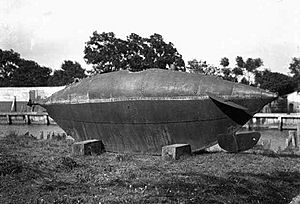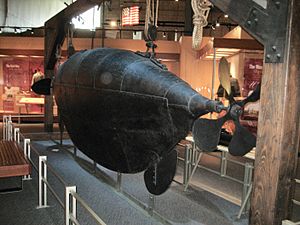Bayou St. John submarine facts for kids

The submarine on display beside Bayou St. John, 1890s
|
|
Quick facts for kids History |
|
|---|---|
| Fate | Scuttled, c. April 1862 |
| Status | Museum ship |
| General characteristics | |
| Type | Submarine |
| Length | 20 ft (6.1 m) |
| Beam | 3 ft (0.91 m) |
| Height | 6 ft (1.8 m) |
| Propulsion | Hand-cranked propeller |
| Armament | Spar torpedo (presumed) |
The Bayou St. John Confederate Submarine is a very early military submarine. It was built for the Confederate States of America during the American Civil War. This submarine is a cool example of how people tried to create new war machines a long time ago.
Contents
The Bayou St. John Submarine
What is it?
This submarine is made from iron plates held together with rivets. It is about 20 feet (6.1 m) long, 3 feet (0.91 m) wide, and 6 feet (1.8 m) deep. That's like a small school bus!
Instead of an engine, it had a propeller that was turned by hand. Imagine having to crank a propeller to make a submarine move underwater!
Its Amazing History
We don't have many old papers or records about this submarine. Because of this, we don't even know its original name. Many details about how it was built or used are still a mystery.
Rediscovery and Early Display
The submarine was found again in 1878. This happened when people were dredging (cleaning out the bottom) of Bayou St. John in New Orleans, Louisiana. It was likely sunk on purpose (this is called scuttling) by the Confederates. They probably did this to stop it from being captured by the Union army when New Orleans was taken over.
After it was found, the submarine was put on display. It sat next to the Bayou at Spanish Fort Amusement Park. For a long time, people thought it was another submarine called the Pioneer.
Later, in the late 1900s, historians looked closer at old records. They found out that the Pioneer looked different from the submarine found in Bayou St. John. It's possible that both submarines were being tested around the same time. This might be why people got them mixed up so long ago.
Moving to a Museum
In 1908, the submarine was moved to the grounds of Camp Nicholls Confederate Home. This place was also next to Bayou St. John. Around this time, someone tried to preserve the submarine by filling its inside with concrete. Later experts wondered if this was the best way to save it.
In 1942, the Louisiana State Museum took ownership of the submarine. It was moved to Jackson Square. It was shown in different spots around the Square. Then, in 1957, it was placed under a covered walkway at the Presbytere building. It stayed there for many years until 1999.
Restoration Work
In 1999, the submarine went on another journey. It was moved to Baton Rouge. Here, a big restoration project began. The old concrete that had been put inside was carefully removed. After this important work, the submarine was put on display at the Capitol Park Museum - Baton Rouge. Today, you can still see this unique piece of history there!


